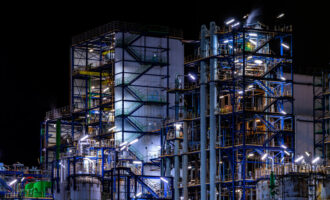LSPI: A knock on the newest engines
By Hank Hogan
For an illustration of the law of unintended consequences, consider the worldwide push to produce cars with higher fuel economy. It’s good for the planet, because it lessens the impact of carbon emissions. But, it may be bad for cars because current approaches to boost fuel economy increase the likelihood of low-speed pre-ignition (LSPI). A combustion abnormality, LSPI can lead to knocking so severe it can destroy an engine.
A series of papers presented at the JSAE/SAE Powertrains, Fuels and Lubricants International Meeting in Kyoto, Japan in September, indicated that LSPI arises from interactions between lubricants, fuels and engine design/operation. With regard to lubricants, there’s one likely culprit: the CaCO3(calcium carbonate) in the detergent additive.
“We have to find an alternative to CaCO3,” said Yasuo Moriyoshi, professor of mechanical engineering at Japan’s Chiba University. Moriyoshi was co-author of a paper on the calcium contribution to LSPI.
He was also involved in an industry research consortium sponsored by Toyota, Honda, Mazda and other OEMs from 2011 to 2013. The results that were presented in September built upon that research.
So, will reformulating an engine oil to be calcium-free solve the low speed pre-ignition problem? Perhaps not. One issue is that getting rid of calcium may be difficult, said Ian Elliott, product development engineer for automotive engine oils at San Ramon, Calif., U.S.A.-based Chevron Oronite. “Eliminating calcium would put unnecessary constraints on the formulator, limiting the tools that can be used to create an oil that has robust performance in other areas, such as cleanliness,” he said.
Elliott also noted that it may not be necessary to remove calcium completely. The additive plays a role in the frequency of LSPI. However, so too do fuel composition and engine design. The focus, therefore, should be on performance rather than chemical limits, he said.

Elliott, who also spoke at the conference, noted that today’s advanced engines have been downsized from earlier generations to increase fuel economy. To produce the power needed to give acceptable performance, the engines have also been turbocharged. As a result, advanced engines now spend much more time in a low-speed high-torque regime that leads to LSPI.
Resolving this issue will probably become more important, Elliott said. A larger percentage of engines are downsized and turbocharged, which means more cars on the road can suffer low-speed pre-ignition and potentially experience engine failure.
An important step in avoiding such issues is developing a test that can tell a good oil from bad, and distinguish between different engine designs with regard to LSPI. To that end, researchers from Chevron Oronite reported on the results from different tests intended to quantify low-speed pre-ignition. One approach is to look for abnormal cylinder pressure spikes. A second is to measure how early combustion occurs by determining the MFB02 point, the point at which 2% of the cylinder charge is burned. A third technique combines the first two, only counting as an LSPI event those times when there is both abnormal cylinder pressure and early combustion. According to Chevron Oronite researchers, this is probably the best method.
There also can be differences in how events are recorded. Pre-ignition in one cycle tends to lead to the same in subsequent cycles. So, in one counting approach, multi-cycle events are grouped together. In another, an event in each cycle is counted separately.
The Chevron Oronite investigation revealed that three different tests produced the same qualitative results. That is, if formulation A was better for LSPI than formulation B in one test, it was better in all tests. But the degree of improvement and the starting point of the LSPI events varied between the different tests.

In discussing this, Elliott noted that a test is an important tool. However, it must be able to statistically differentiate between high and low LSPI activity oils and do so repeatedly. It also has to reasonably represent field conditions.
“A single test may meet the needs of the industry, as long as all the technical details are clear so there is less room for different interpretations,” he said.
Additive maker Afton Chemical of Richmond, Va., U.S.A. is also investigating LSPI. Ian Bell, senior R&D director, noted that in addition to calcium-based detergents, other components of the finished lubricant can have a substantial effect.
“For instance, there is a clear impact from all organic materials, and base oils can also be significant,” Bell said.
Other factors also play a role. For example, different engine hardware designs and combustion management strategies can have an influence that is greater than that of the lubricant formulation, Bell said. Consequently, he added, the solution must be a systems approach involving engine, fuel and lubricant.
Finding a solution is a pressing problem, particularly for next-generation passenger cars that have to achieve regulation-driven higher fuel economy. For instance, future vehicles will have to meet the U.S. mandated 54.5 mile per gallon fleet corporate average fuel economy (CAFE) standard in 2025, a near doubling of fuel efficiency as compared to that required of cars as little as five years ago. Other regions are also raising their fuel economy requirements. Therefore, cars will increasingly be operating in regimes where LSPI events will likely be more common.
At F+L Week 2015 organised by F&L Asia in Singapore in March 2015, Afton Chemical presented a survey of LSPI performance for a range of commercial GF-5 products, showing that all lube technologies tested failed proposed LSPI requirements. So, formulations will have to change, Bell said.
LSPI is not a simple problem, said Thomas Briggs, Jr., manager of engine systems research and development at Southwest Research Institute in San Antonio, Texas, U.S.A. Briggs led a team working with industry partners GM, Ford, Honda and other OEMs that investigated low-speed pre-ignition beginning in 2011. The group used specialized tools, such as high-speed video and crevice sampling, to better determine the source of the problem.
The captured video showed that droplets of material were coming out of the piston crevice in the engine. Sometimes those droplets burned, leading to LSPI and strong engine knock. The video showed that the material was a fluid. The team devised methods to pull the fluid out of the crevice and then tested it to study its chemical composition.
“It’s fuel. It’s lube. It’s other material. So, it’s a complex cocktail of fluids,” Briggs said.
 By 2014 the program wrapped up, having produced information that gave additive companies a rough idea of what was needed to solve the problem. Briggs noted that LSPI arises when engines are in the 1500-2000 rpm range, a relatively slow speed, while still exerting plenty of torque. That’s also when a large supply of fuel is present. Yesterday’s engines spent little time in these operating conditions, although Briggs thinks they too would experience LSPI if they had.
By 2014 the program wrapped up, having produced information that gave additive companies a rough idea of what was needed to solve the problem. Briggs noted that LSPI arises when engines are in the 1500-2000 rpm range, a relatively slow speed, while still exerting plenty of torque. That’s also when a large supply of fuel is present. Yesterday’s engines spent little time in these operating conditions, although Briggs thinks they too would experience LSPI if they had.
Tests exist that can readily discriminate between the LSPI impact of various formulations, Briggs said. These are being further refined into upcoming ILSAC GF-6 and GM dexos LSPI tests. With the right tests and the research already done, Briggs is confident that formulators and the industry as a whole can come up with the recipe to solve the problem.
That will come about, in part, as a result of continued research on the mechanisms behind and possible fixes for LSPI. For instance, an industry consortium is being formed, with a target start date of April 2016. Researchers from Chiba University will be part of this effort, but the focus will be different than the previous work of the consortium.
“Oil companies are interested in what kind of detergent affects pre-ignition,” Moriyoshi said.
Southwest Research Institute is also involved in a follow-up consortium which started in 2014 and is scheduled to wrap up in 2018. Currently, ways are being investigated to replicate what happens in an engine on a test bench, which will give researchers greater access and more tools to understand what is going on. The goal is to determine the chemical steps that lead to LSPI, which will help in figuring out what should be done to address it.
Lube formulations are a current focus, but in time attention may turn to fuels. There have been some published results that indicate different fuels, whether due to regional variations, tank aging, or other factors, could have an impact. This can be of particular concern to OEMs that might, for instance, be selling products in China at a time when the government mandates a change in fuel composition – perhaps as part of an effort to reduce CO2 emissions.
“You can get a wide range of severity of the problem, depending on the fuel,” said Briggs.







